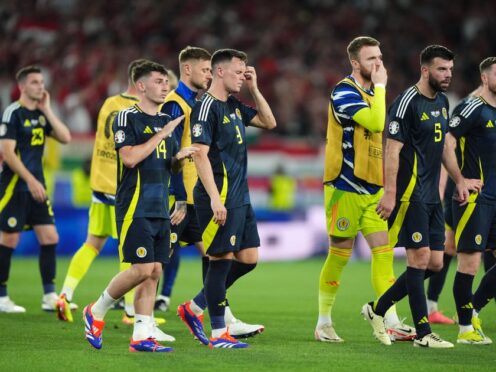
Scotland suffered group-stage elimination after taking just one point from their three matches for the second successive European Championship.
Here, the PA news agency assesses where it all went wrong for Steve Clarke’s side.
How can Scotland’s tournament be summarised?
🇭🇺 Csoboth's winner in the 100th minute… 😲#LastMinuteMoments | @Hublot pic.twitter.com/vr2eQcZ2MX
— UEFA EURO 2024 (@EURO2024) June 23, 2024
Deflating. The Scots went into the Euros on the back of poor form and beset by injuries, but there was still a sense among their supporters that everything might click once they arrived in Germany. As it transpired, Scotland lived down to their billing as the fourth-ranked side in the section. They started with a terrible display and a 5-1 defeat to Germany, responded with a pride-restoring performance in a creditable 1-1 draw with Switzerland, and then ended it in underwhelming fashion in Stuttgart, competing with Hungary for most of the evening in general play but without looking particularly threatening before being sucker-punched at the death.
What is the general consensus on Scotland’s performances in Germany?

There is a widespread sense they are returning home not having fired all their shots. Indeed they had the fewest shots on goal of any team in the competition. The Germany game was a write-off, with the team resembling rabbits in headlights on the opening night. The second game was much better but still there was a feeling in some quarters that with slightly more attacking intent they could have nicked a win. And after the Hungary game, Scotland were heavily criticised for not penetrating their opponents enough on a night when – surprisingly – they were able to enjoy the lion’s share of the possession.
What are the main gripes among supporters and commentators?

That Scotland played too cautiously, particularly when they needed a win against Hungary. With their opponents sitting off in a low block, Clarke’s team had loads of the ball but passed it sideways and backwards far too often and never really looked like they had the wherewithal to get in behind. While the starting XI in each of the three games carried few surprises, there was a sense that the manager could have thrown off the shackles earlier against both Switzerland and Hungary, with the lack of game time for attacking players like Lawrence Shankland, Ryan Christie and James Forrest a particular bugbear for many.
How damaging were the injuries?

Extremely. Lyndon Dykes’ presence and power in attack was badly missed. Similarly, the Scots could desperately have done with Aaron Hickey at right wing-back to provide thrust and quality going forward. It would also have been of benefit to be able to call on someone like Bologna playmaker Lewis Ferguson when chasing goals in the closing stages of matches, while Kieran Tierney’s mid-tournament injury diminished Scotland’s ability to pass or drive forward from defence.
Were there any ‘what if’ moments?

There are two that jump out. At 1-1 against the Swiss, Grant Hanley saw a close-range header come agonisingly back off the post. And in the closing stages of the Hungary game, while still goalless, the Scots were denied what looked a stonewall penalty when substitute Stuart Armstrong seemed to be fouled by Willi Orban.
What’s next for Scotland?

Reasons for optimism are thin on the ground. Scotland have now won only one of their last 12 matches – against Gibraltar – since September and following this demoralising group-stage exit, Clarke has lost a lot of the goodwill he built up among supporters after leading Scotland to back-to-back Euros. Indeed, although he remains under contract until after the 2026 World Cup, there is sure to be frenzied debate about the manager’s future in the coming days, while it remains to be seen if the 60-year-old Ayrshireman will have the appetite to soldier on in the face of the criticism currently coming his way. With few emerging players banging down the door to step in and improve the situation, the beleaguered Scots must somehow rouse themselves for a Nations League campaign in which they are grouped with Croatia, Poland and Portugal.

Enjoy the convenience of having The Sunday Post delivered as a digital ePaper straight to your smartphone, tablet or computer.
Subscribe for only £5.49 a month and enjoy all the benefits of the printed paper as a digital replica.
Subscribe